| |
Circumnavigating Africa - Part 3
Namibia - Southampton, England
Fall 2014 |
| Click here to see the cruise itinerary |
| |
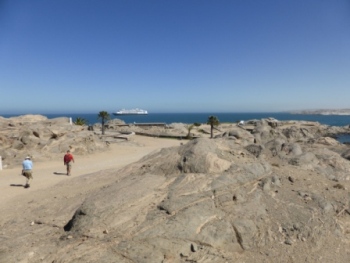 |
|
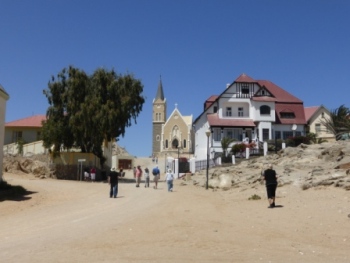 |
| After riding a tender ship to Luderitz, Namibia Paul & friend, Mike Norman, walked out on a peninsula that was actually and RV park complete with water & electric hookups! Our ship is in the background. |
|
The town is a German settlement and the main church, the Felsenkirche (Church of the Rock) Lutheran Church, houses and other buildings were colonial German style. |
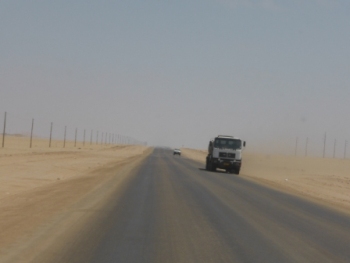 |
|
 |
| In Walvis Bay, Namibia we drove for hours on a "salt road" constructed by pouring sea water on powdered rock that is high in gypsum. The heat and dry air quickly change the surface into a plaster-of-paris-like road. If it weren't for the black tire marks, the road would be white. |
|
Out in the Namib-Naukluft National Park, we found one wadi that had about 50 of these Welwitschia plants. This amazing plant is over 1,000 years old! |
 |
|
 |
| We tried to scale Dune 7 standing up, but it was so steep we had to use our hands to climb as the sand slipped away under our feet. |
|
Our guide set up a picnic lunch - lasagna, salad, paté, and apple cobbler - on a portable table complete with table cloth under one of the few trees in the dry Swakop River Valley. |
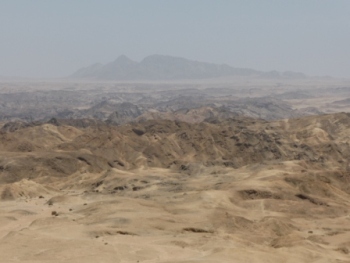 |
|
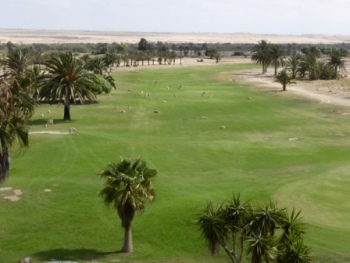 |
| This area of the Namib desert is known a the "Moonscape" because of its resemblance to the lunar landscape. |
|
At the Rössmund Golf Club in Swakopmund, we were delighted to see the fairways dotted with a herd of springbok (a type of antelope). |
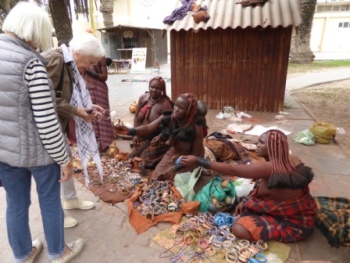 |
|
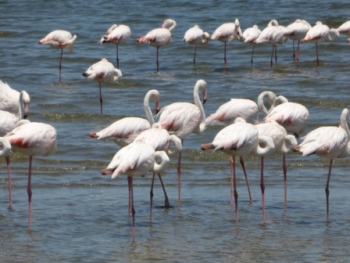 |
| Local women from the Ova himba tribe sat on blankets displaying their handmade trinkets (and their bare breasts). Their hair and bodies have a reddish cast because they rub an ochre clay on themselves as perfume and insect repellent. |
|
Large flocks of pink flamingos stood all day in the lagoon at Walvis Bay. |
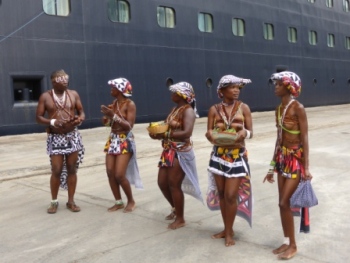 |
|
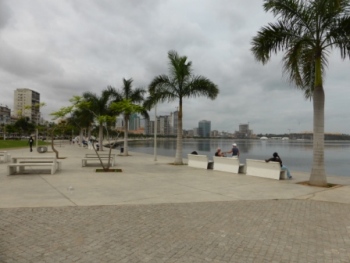 |
| Topless women and one man dancer greeted us shipside when we arrived in Luanda, Angola. |
|
We walked from the ship along the Marginal, a promenade next to Luanda Bay, out to San Miguel Fort. The Marginal has a lovely, well manicured grass area all the way there; but the terrible smells coming from the polluted water made the walk unpleasant - not to mention the presence of truckloads of armed guards/police/security in front of every store and bank. |
 |
|
 |
| Luanda has been named the most expensive city in the world, but not everyone shares in the oil wealth of the country. These maids waited for a commuter taxi. |
|
The Cape Verde Islands, off of the coast of Senegal, naturally have a lot of African influence; but they speak a portuguese creole. The market in Praia, on the Ilha de Santiago was packed with people. |
 |
|
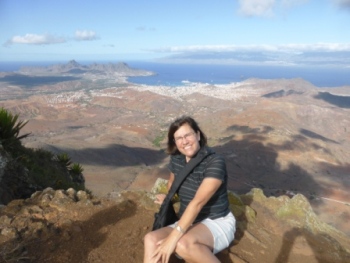 |
| Local women amazingly balance their purchases on their heads and carry more in their hands! |
|
We also toured the island of São Vicente. From Monte Verde we looked down at the port city of Mindelo. |
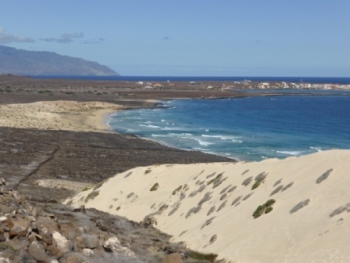 |
|
 |
| The dramatic beaches of the Praia do Norte had rolling surf, large sand dunes and lots of volcanic rock. While we were here, there was an volcanic eruption on another Cape Verdean island. |
|
The greenery on the island of Tenerife in Spain's Canary Islands were a welcome sight after the stark landscape of Cape Verde. This floral mosaic was on the side of the tourism bureau. We took a light rail train to La Laguna up in the mountains with friends, Mike & Linda. |
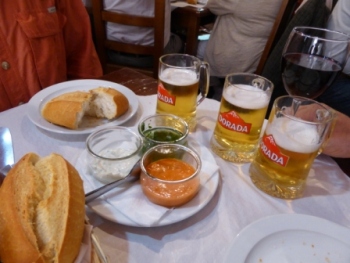 |
|
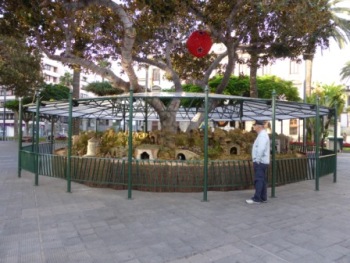 |
| Of course, we wanted to sample the local wine, beer, and mojos (3 typical salsas) - an ailoli, a spicy one, and one with lots of garlic, parsley and olive oil. All delicious! |
|
In Las Palmas, Gran Canaria, Paul checked out the huge nativity display in Parque San Telmo. |
 |
|
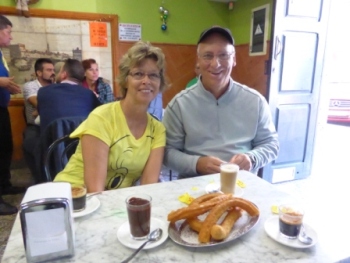 |
| As you walked around the display, scenes from the entire story were depicted - from the annunciation to the slaying of the children in Bethlehem (shown above). |
|
Near the market, we enjoyed fantastic churros & chocolate at Churrería Mayda. |
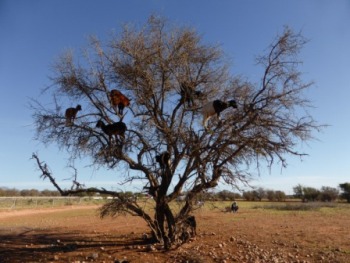 |
|
 |
| We left the city of Agadir, Morocco to see the Argan trees along the highways. The seeds are so delectible that goats climb the trees and stand there eating them! |
|
After 1 1/2 hours, we arrived in Taroudant and saw women grinding the argan seeds to make a paste that is used to make cosmetic soaps & oils. |
 |
|
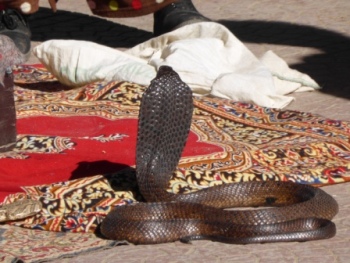 |
| The snow covered High Atlas mountians towered over the11th Century red mud ramparts of the city. |
|
Inside the walls, we saw a Berber snake charmer who coaxed this King cobra snake to flare its cape. |
 |
|
 |
| Inside the souk (market), a merchant sold bath soap from the front right bucket. The consistancy of Crisco; it was scooped out and put in a piece of waxed paper to carry home. The straps hanging above were used to spread the soap and pull back and forth over your body. |
|
Ladies who don't have artistic talents purchase these stencils to create henna designs on their hands and feet. |
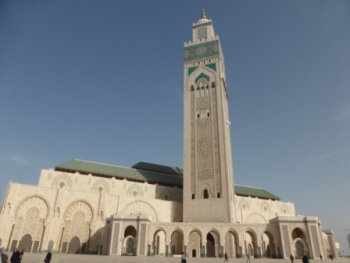 |
|
 |
| The Hassan II Mosque in Casablanca, Morocco is the third largest mosque in the world. |
|
It is located on a platform that actually hovers over the Atlantic Ocean. Inside the capacity is 25,000 worshipers; but 100,000 pack the grounds inside & out to attend the high religious festival ceremonies. |
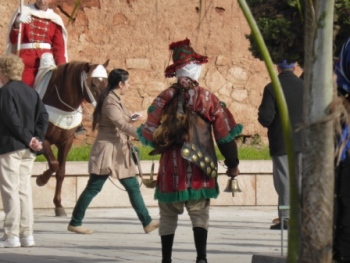 |
|
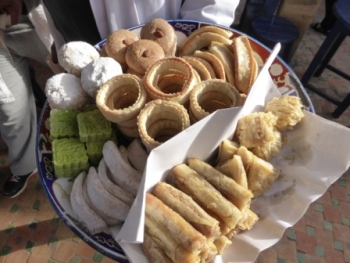 |
| In Rabat, the capital of Morocco, we saw watersellers carrying goat skins filled with water; which they serve in golden cups. They rang a golden bell to call attention to themsleves; along with wearing a funny hat and colorful clothing. |
|
We sat at a seaside cafe and watched the crashing surf while enjoying local pastries and delicious mint tea. |
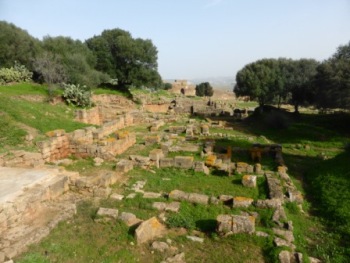 |
|
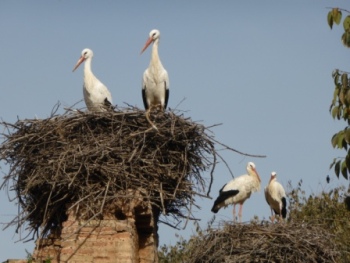 |
| The Phoenician town of Chellah is a necropolis that contains Roman ruins. We counted 14 storks in nests there. |
| |



































































